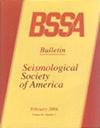Recurrence and Long-Term Evaluation of Kanto Earthquakes
IF 2.9
3区 地球科学
Q2 GEOCHEMISTRY & GEOPHYSICS
引用次数: 3
Abstract
The 1923 Taisho Kanto earthquake—an interplate event along the Sagami trough where the Philippine Sea plate subducts beneath the Kanto region—produced ground shaking, crustal deformation, landslides, and tsunamis, and caused the worst earthquake disaster in Japan. Based on seismological and geodetic data, many fault models have been proposed, extending ∼100 km from the epicenter, with a moment magnitude (Mw) of 7.8–8.2, and large slips of ∼8 m located near the epicenter and beneath the Miura Peninsula. The penultimate 1703 Genroku Kanto earthquake produced similar macroseismic effects around Sagami Bay and the Miura Peninsula, but larger coastal uplift and tsunami in the Boso Peninsula. The proposed fault models extend off the Boso Peninsula with Mw of 8.1–8.5. In 2004, the Earthquake Research Committee (ERC) classified the Kanto earthquakes as “Taisho type” and “Genroku type” with recurrence intervals of 200–400 yr and 2300 yr, respectively. In 2014, the ERC revised the long-term evaluation to a recurrence interval of 180–590 yr and a 30 yr probability of 0%–5% based on the Brownian passage time model. With the Cabinet Office, the ERC considered the source area of the maximum possible earthquake of Mw 8.6–8.7. The recent historiographical and paleoseismological studies have identified other candidates for the past Kanto earthquakes in 1495, 1433, 1293, and 878. Various combinations of these candidates give a mean recurrence interval of 210–315 yr, an aperiodicity parameter of 0.04–0.76, and a 30 yr probability of 0.0%–19%. The Cabinet Office has calculated the seismic intensity and tsunami heights of various types of Kanto earthquakes. National and local governments estimate the damage from these hazards. For the Tokyo metropolitan area, the estimated damage and occurrence probability are more significant for M ∼7 earthquakes with various types and depths, and most mitigation efforts are directed at such events.关东地震的复发与长期评价
1923年的大正关东地震——一个沿相模海槽的板块间事件,菲律宾海板块在关东地区的下方俯冲——产生了地面震动、地壳变形、山体滑坡和海啸,并造成了日本最严重的地震灾害。根据地震学和大地测量数据,已经提出了许多断层模型,从震中延伸到100公里,矩震级(Mw)为7.8-8.2,震中附近和三浦半岛下方有8米的大滑动。1703年关东元禄第二次地震在相模湾和三浦半岛周围产生了类似的宏观地震效应,但在波索半岛产生了更大的沿海隆起和海啸。所提出的断层模式向波索半岛外延伸,Mw为8.1 ~ 8.5。2004年,地震研究委员会(ERC)将关东地震划分为“大正型”和“元陆型”,分别为200-400年和2300年的重复周期。2014年,ERC根据布朗通过时间模型将长期评估修正为180-590年的复发间隔和0%-5%的30年概率。与内阁府一起,ERC考虑了8.6-8.7级最大可能地震的震源区域。最近的史学和古地震学研究已经确定了1495年、1433年、1293年和878年关东地震的其他候选事件。这些候选组合的平均复发间隔为210-315年,非周期性参数为0.04-0.76,30年概率为0.0%-19%。日本内阁府计算了关东地区各种类型地震的地震烈度和海啸高度。国家和地方政府估计了这些灾害造成的损失。对于东京大都市区,各种类型和深度的M ~ 7级地震的估计损失和发生概率更为显著,并且大多数减灾工作都针对此类事件。
本文章由计算机程序翻译,如有差异,请以英文原文为准。
求助全文
约1分钟内获得全文
求助全文
来源期刊

Bulletin of the Seismological Society of America
地学-地球化学与地球物理
CiteScore
5.80
自引率
13.30%
发文量
140
审稿时长
3 months
期刊介绍:
The Bulletin of the Seismological Society of America, commonly referred to as BSSA, (ISSN 0037-1106) is the premier journal of advanced research in earthquake seismology and related disciplines. It first appeared in 1911 and became a bimonthly in 1963. Each issue is composed of scientific papers on the various aspects of seismology, including investigation of specific earthquakes, theoretical and observational studies of seismic waves, inverse methods for determining the structure of the Earth or the dynamics of the earthquake source, seismometry, earthquake hazard and risk estimation, seismotectonics, and earthquake engineering. Special issues focus on important earthquakes or rapidly changing topics in seismology. BSSA is published by the Seismological Society of America.
 求助内容:
求助内容: 应助结果提醒方式:
应助结果提醒方式:


